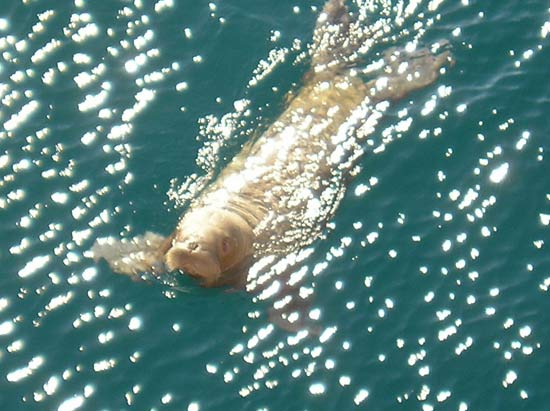Stranded Walrus Pups Cry for Help

On a summer research cruise through the Arctic Ocean aboard the icebreaker Healy, scientists were surrounded by an unprecedented number of barking, abandoned walrus pups.
Strict restrictions on interacting with marine mammals prevented the researchers rescuing the nine pups, which were probably abandoned when their moms were forced to chase rapidly retreating seasonal sea ice.
"We would sail to a particular location and stay there for 24 hours at a time, and one or two of these pups would swim up to us, and the poor little guys would just bark at us for hours on end," said Carin Ashjian, a research team member from Woods Hole Oceanographic Institute. "It was really awful. I wouldn't go outside."
The pups likely drowned or starved to death.
Today, scientists announced the results of the 2004 cruise and what they think was behind the crying pups.
Mother-pup bond
Adult Pacific walrus, Odobenus rosmarus divergens, dive as deep as 630 feet (200 meters) and use sensitive facial bristles to forage for clams and crabs on the seafloor.
Get the world’s most fascinating discoveries delivered straight to your inbox.
But walrus pups can't forage for themselves and rely on their mother's milk for up to two years.
Mother walruses take their young nearly everywhere they go, but they need a safe place to leave the pups when it's time to find food or if they both need a rest from swimming.
Ice platforms floating over shallow waters have traditionally been the perfect place for both these needs.
The walruses follow these platforms as they retreat northward in summer.
Icy retreat
So why were these pups left alone in deep waters?
The researchers found evidence that in the summer of 2004, water 6 degrees Fahrenheit warmer than usual washed into the Canada Basin. This might have caused the seasonal sea ice over the shallow spots to melt quicker than usual or drift to deeper, colder waters.
"We think ... the ice retreated really quickly," Ashjian told LiveScience. "We think the mothers had to keep up with the ice and the babies couldn't keep pace and were left behind."
In areas where the ice remained, the bottom is up to 9,300 feet (3,000 meters) deep. That's too deep for a walrus to dive and feed, so the mothers may have swam off looking for better feeding opportunities, leaving their pups behind to fend for themselves.
This is the latest evidence of animals struggling to deal with climate change. A recent study suggests that a quarter of the world's animal and plant species could be extinct by 2050. Studies have also suggested polar bears could struggle for survival as Arctic ice retreats.
"If walruses and other ice-associated marine mammals cannot adapt to caring for their young in shallow waters without sea-ice available as a resting platform between dives to the sea floor, a significant population decline of this species could occur," the research team wrote in the April issue of the journal Aquatic Mammals.
The lead author of the study is Lee Cooper, a biogeochemist at the University of Tennessee.
Other climate change effects


